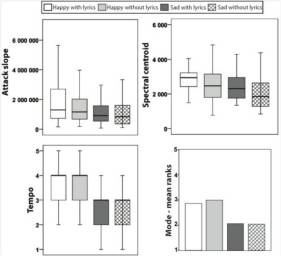While travelling in Paris, I’ve passed quite a few musicians performing on the streets, whether they are singing, playing an instrument, or both. As someone who listens to music almost nonstop, I always find myself feeling a little brighter after I pass by these performers during my daily outings. What can I say? Music makes me happy, and good music happier. It’s not often that one finds time and space just for listening to music, but the “Electro: From Kraftwerk to Daft Punk” exhibit at the Philharmonie de Paris offered me this very opportunity, revisualizing the sonic experience of electronic dance music (EDM) into an immersive physical space. Tracing the origins of EDM to the present and featuring the works by renowned duo Daft Punk, “Electro” left me thinking about EDM for quite some time after I’d left. How do our brains process and respond to music, and how might the case be different for EDM?
Research suggests that listening to music is more complex than we might think, as it activates an entire network of cortical and subcortical areas (Zatorre and Krumhansl, 2002). Even the perception of rhythm involves multiple brain regions (Zatorre et al., 2007). When we hear music we like, our reward systems may activate, and when we tap our feet or bob our heads, we do so almost unbeknownst ourselves through activation of the basal ganglia (Trost et al., 2014; Zatorre et al., 2007).
A recent functional magnetic resonance imaging (fMRI) study by Brodal and colleagues examined the relationship between rhythmic music and basal ganglia, an area of the brain typically associated with fine motor skills (Hikosaka et al., 2002; Brodal et al., 2017). To test participants, researchers created a continuous-stimulation design (10.16 minutes long, 120 beats per minute) using an EDM-style composition. Ambient noise generated by the MR scanner was synchronized with the music to mimic an accompanying instrument and to prevent disturbance of participants’ listening experiences. The continuous-stimulation design was a departure from previous studies’ use of short chunks of music, which Brodal and colleagues believed may have caused limitations (Brodal et al., 2017).

Regions researchers observed. (Brodal et al., 2017)
Researchers used stochastic dynamic causal modeling (sDCM), a technology used to examine interactions between auditory perception, rhythm processing, and reward processing, to observe connectivity in the auditory cortex, putamen/pallidum (PP), and ventral striatum/nucleus accumbens (VSNAc) of both hemispheres. The latter two grouped terms were chosen for this study because the low resolution of raw fMRI data prevented distinction between grouped locations.
The sDCM revealed significant connections between all three areas in both hemispheres, as well as reduced functional connectivity in the reward system. Results supported the hypothesis that stimulation from rhythmic EDM-like music decreases connectivity in the right VSNAc from and to the basal ganglia and auditory network. Stimulation also resulted in decreased self-inhibition via the VSNAc, as well as changed hemodynamic parameter of the VSNAc, suggesting an increased level of activation. Furthermore, reduced connectivity was observed in basal ganglia, reward system, basal ganglia and auditory network. Ultimately, results demonstrated reduced reward system connectivity in participants listening to rhythmic music, thus supporting the hypothesis that the ventral striatum/nucleus accumbens region plays a significant role in processing the emotions associated with listening to music (Koelsch, 2014).
As Brodal and colleagues note themselves, one weakness of the study is its methodological constraints. Though evidence already exists on rhythm and the observed effects, researchers’ use of only one music piece prevents confident establishment of a connection, at least in relation to the present study (Brodal et al., 2017). Furthermore, participants’ states while listening to the given music is only compared to one other state, the resting state. Brodal and colleagues note that it is thus impossible to definitively determine whether the observed effects emerged during the resting state (Brodal et al., 2017). Lastly, though not a weakness, laboratory conditions in the Brodal team’s study are far different from normal conditions in which one might listen to music. EDM in particular is often celebrated at large outdoor festivals, and it would be interesting to understand how music interacts with festival environments and other relevant factors to affect our emotions, reward circuits, and capacity for inhibition.
Or who knows? Maybe I’ll see for myself at my next EDM festival. In an era of increasing technologization, electronic music represents not only technology, but also the capability of technology to bring humans together. And it’s comforting knowing that something so powerful can serve us by bringing us joy.
References
Brodal HP, Osnes B, Specht K (2017) Listening to rhythmic music reduces connectivity within the basal ganglia and the reward system. Frontiers in Neuroscience. 11:153. https://doi.org/10.3389/fnins.2017.00153.
Hikosaka O, Nakamura K, Sakai K, Nakahara H (2002) Central mechanisms of motor skill learning. Current Opinion in Neurobiology 12(2):217-222. https://doi.org/10.1016/S0959-4388(02)00307-0.
Koelsch S (2014) Brain correlates of music-evoked emotions. Nature Reviews: Neuroscience. 15:170-180. https://doi.org/10.1016/j.plrev.2015.03.001.
Cité de la Musique: Philharmonie de Paris (n.d.) The Electro exhibition.
Trost W, Frühholz S, Schӧn D, Labbé C, Pichon S, Grandjean D, Vuilleumier P (2014) Getting the beat: Entrainment of brain activity by musical rhythm and pleasantness. NeuroImage 103:55-64. https://doi.org/10.1016/j.neuroimage.2014.09.009.
Zatorre RJ, Chen JL, Penhune VB (2007) When the brain plays music: Auditory-motor interactions in music perception and production. Nature Reviews: Neuroscience 8:547-558. https://doi.org/10.1038/nrn2152.
Zatorre RJ, Krumhansl CL (2002) Mental models and musical minds. Science 298:2138-2139. https://doi.org/10.1126/science.1080006.
Image 1-2 taken by myself
Image 3 taken from (Brodal et al., 2017).





























![I have stayed with 3 homestays and lived in the Cité Universitaire over the past 5 years. [image souce: Google maps]](https://i0.wp.com/scholarblogs.emory.edu/nbbparis/files/2015/06/Blog-1-300x230.png?resize=300%2C230)
![The brain Broca studied at Musée Dupuytren [image source: google images]](https://i0.wp.com/scholarblogs.emory.edu/nbbparis/files/2015/06/Blog-Pic-2-159x300.png?resize=159%2C300)




